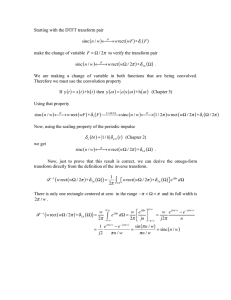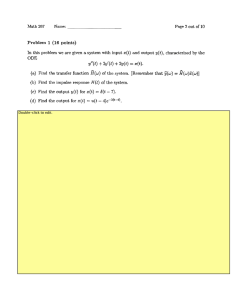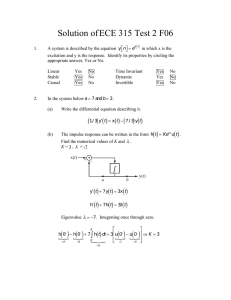Solution of EECS 315 Test 7 F13 ( )
advertisement
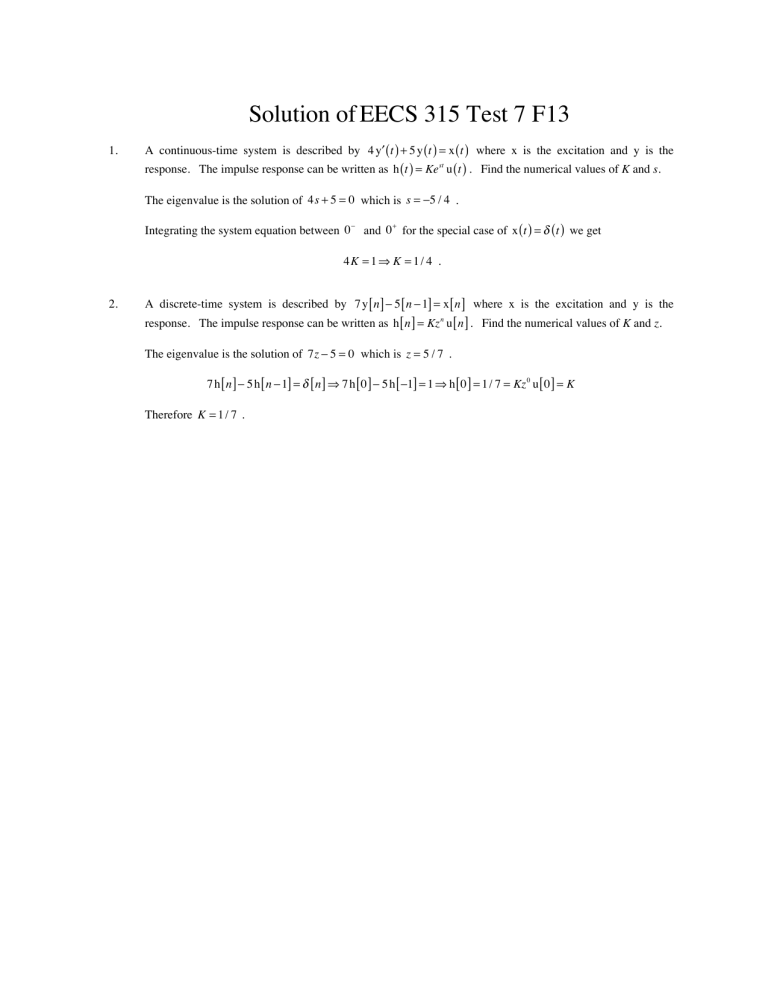
Solution of EECS 315 Test 7 F13 1. A continuous-time system is described by 4 y′ ( t ) + 5 y ( t ) = x ( t ) where x is the excitation and y is the response. The impulse response can be written as h ( t ) = Ke st u ( t ) . Find the numerical values of K and s. The eigenvalue is the solution of 4s + 5 = 0 which is s = −5 / 4 . Integrating the system equation between 0 − and 0 + for the special case of x ( t ) = δ ( t ) we get 4K = 1 ⇒ K = 1 / 4 . 2. A discrete-time system is described by 7 y [ n ] − 5 [ n − 1] = x [ n ] where x is the excitation and y is the response. The impulse response can be written as h [ n ] = Kz n u [ n ] . Find the numerical values of K and z. The eigenvalue is the solution of 7z − 5 = 0 which is z = 5 / 7 . 7 h [ n ] − 5 h [ n − 1] = δ [ n ] ⇒ 7 h [ 0 ] − 5 h [ −1] = 1 ⇒ h [ 0 ] = 1 / 7 = Kz 0 u [ 0 ] = K Therefore K = 1 / 7 . 3. ⎛ t − 1⎞ ∗ ⎡ 2δ ( t − 3) + 3δ ( t + 1) ⎤⎦ , find the numerical value of x (1) . If x ( t ) = rect ⎜ ⎝ 4 ⎟⎠ ⎣ ⎛ t − 1⎞ ⎛ t − 1⎞ x ( t ) = 2 rect ⎜ ∗ δ ( t − 3) + 3rect ⎜ ∗ δ ( t + 1) ⎝ 4 ⎟⎠ ⎝ 4 ⎟⎠ ⎛ t − 4⎞ ⎛t⎞ ⎛ −3 ⎞ ⎛ 1⎞ x ( t ) = 2 rect ⎜ + 3rect ⎜ ⎟ ⇒ x1( t ) = 2 rect ⎜ ⎟ + 3rect ⎜ ⎟ = 3 ⎝ 4 ⎟⎠ ⎝ 4⎠ ⎝ 4⎠ ⎝ 4⎠ =0 4. =1 A discrete-time system is described by 20 y [ n ] − 4 y [ n − 1] − 3y [ n − 2 ] = x [ n ] where x is the excitation and y is the response. ( ) The impulse response can be written as h [ n ] = K1z1n + K 2 z2n u [ n ] . Find the numerical values of K1 , K 2 , z1 and z2 . The eigenvalues are the solutions of 20z 2 − 4z − 3 = 0 which are z = 0.5 and z = −0.3 . 20 h [ n ] − 4 h [ n − 1] − 3y [ n − 2 ] = δ [ n ] ⇒ 20 h [ 0 ] − 4 h [ −1] − 3h [ −2 ] = 1 ⇒ h [ 0 ] = 1 / 20 = ( K1z10 + K 2 z20 ) u [ 0 ] = K1 + K 2 20 h [1] − 4 h [ 0 ] − 3h [ −1] = 0 ⇒ h [1] = 1 /100 = ( K1z11 + K 2 z12 ) u [ 0 ] = 0.5K1 − 0.3K 2 =1/20 Solving simultaneously, K1 = 0.03125 and K 2 = 0.01875 Solution of EECS 315 Test 7 F13 1. A continuous-time system is described by 3 y′ ( t ) + 8 y ( t ) = x ( t ) where x is the excitation and y is the response. The impulse response can be written as h ( t ) = Ke st u ( t ) . Find the numerical values of K and s. The eigenvalue is the solution of 3s + 8 = 0 which is s = −8 / 3 . Integrating the system equation between 0 − and 0 + for the special case of x ( t ) = δ ( t ) we get 3K = 1 ⇒ K = 1 / 3 . 2. A discrete-time system is described by 10 y [ n ] − 3[ n − 1] = x [ n ] where x is the excitation and y is the response. The impulse response can be written as h [ n ] = Kz n u [ n ] . Find the numerical values of K and z. The eigenvalue is the solution of 10z − 3 = 0 which is z = 3 /10 . 10 h [ n ] − 3h [ n − 1] = δ [ n ] ⇒ 10 h [ 0 ] − 3h [ −1] = 1 ⇒ h [ 0 ] = 1 /10 = Kz 0 u [ 0 ] = K Therefore K = 1 /10 . 3. ⎛ t + 1⎞ ∗ ⎡ 2δ ( t − 2 ) + 3δ ( t + 1) ⎤⎦ , find the numerical value of x (1) . If x ( t ) = rect ⎜ ⎝ 4 ⎟⎠ ⎣ ⎛ t + 1⎞ ⎛ t + 1⎞ x ( t ) = 2 rect ⎜ ∗ δ ( t − 2 ) + 3rect ⎜ ∗ δ ( t + 1) ⎝ 4 ⎟⎠ ⎝ 4 ⎟⎠ ⎛ t − 1⎞ ⎛ t + 2⎞ ⎛ 0⎞ ⎛ 3⎞ x ( t ) = 2 rect ⎜ + 3rect ⎜ ⇒ x (1) = 2 rect ⎜ ⎟ + 3rect ⎜ ⎟ = 2 ⎝ 4 ⎟⎠ ⎝ 4 ⎟⎠ ⎝ 4⎠ ⎝ 4⎠ =1 4. =0 A discrete-time system is described by 10 y [ n ] − y [ n − 1] − 2 y [ n − 2 ] = x [ n ] where x is the excitation and y is the response. ( ) The impulse response can be written as h [ n ] = K1z1n + K 2 z2n u [ n ] . Find the numerical values of K1 , K 2 , z1 and z2 . The eigenvalues are the solutions of 10z 2 − z − 2 = 0 which are z = 0.5 and z = −0.4 . 10 h [ n ] − h [ n − 1] − 2 y [ n − 2 ] = δ [ n ] ⇒ 10 h [ 0 ] − h [ −1] − 2 h [ −2 ] = 1 ⇒ h [ 0 ] = 1 /10 = ( K1z10 + K 2 z20 ) u [ 0 ] = K1 + K 2 10 h [1] − h [ 0 ] − 2 h [ −1] = 0 ⇒ h [1] = 1 /100 = ( K1z11 + K 2 z12 ) u [ 0 ] = 0.5K1 − 0.4K 2 =1/10 Solving simultaneously, K1 = 0.05556 and K 2 = 0.04444 Solution of EECS 315 Test 7 F13 1. A continuous-time system is described by 9 y′ ( t ) + 2 y ( t ) = x ( t ) where x is the excitation and y is the response. The impulse response can be written as h ( t ) = Ke st u ( t ) . Find the numerical values of K and s. The eigenvalue is the solution of 9s + 2 = 0 which is s = −2 / 9 . Integrating the system equation between 0 − and 0 + for the special case of x ( t ) = δ ( t ) we get 9K = 1 ⇒ K = 1 / 9 . 2. A discrete-time system is described by 11y [ n ] − 4 [ n − 1] = x [ n ] 11y [ n ] − 4 [ n − 1] = x [ n ] where x is the excitation and y is the response. numerical values of K and z. The impulse response can be written as h [ n ] = Kz n u [ n ] . The eigenvalue is the solution of 11z − 4 = 0 which is z = 4 /11 . 11h [ n ] − 4 h [ n − 1] = δ [ n ] ⇒ 11h [ 0 ] − 4 h [ −1] = 1 ⇒ h [ 0 ] = 1 /11 = Kz 0 u [ 0 ] = K Therefore K = 1 /11 . Find the 3. ⎛ t − 3⎞ ∗ ⎡ 2δ ( t − 5 ) + 7δ ( t + 2 ) ⎤⎦ , find the numerical value of x (1) . If x ( t ) = rect ⎜ ⎝ 8 ⎟⎠ ⎣ ⎛ t − 3⎞ ⎛ t − 3⎞ x ( t ) = 2 rect ⎜ ∗ δ ( t − 5 ) + 7 rect ⎜ ∗ δ (t + 2 ) ⎝ 8 ⎟⎠ ⎝ 8 ⎟⎠ ⎛ t − 8⎞ ⎛ t − 1⎞ ⎛ −7 ⎞ ⎛ 0⎞ x ( t ) = 2 rect ⎜ + 7 rect ⎜ ⇒ x (1) = 2 rect ⎜ ⎟ + 7 rect ⎜ ⎟ = 7 ⎝ 8 ⎟⎠ ⎝ 4 ⎟⎠ ⎝ 8⎠ ⎝ 8⎠ =0 =1 4. A discrete-time system is described by 50 y [ n ] + 25 y [ n − 1] + 2 y [ n − 2 ] = x [ n ] where x is the excitation and y is the response. ( ) The impulse response can be written as h [ n ] = K1z1n + K 2 z2n u [ n ] . Find the numerical values of K1 , K 2 , z1 and z2 . The eigenvalues are the solutions of 50z 2 + 25z + 2 = 0 which are z = −0.4 and z = −0.1 . 50 h [ n ] + 25 h [ n − 1] + 2 y [ n − 2 ] = δ [ n ] ⇒ 50 h [ 0 ] + 25 h [ −1] + 2 h [ −2 ] = 1 ⇒ h [ 0 ] = 1 / 50 = ( K1z10 + K 2 z20 ) u [ 0 ] = K1 + K 2 50 h [1] + 25 h [ 0 ] + 2 h [ −1] = 0 ⇒ h [1] = −1 /100 = ( K1z11 + K 2 z12 ) u [ 0 ] = −0.4K1 − 0.1K 2 =1/50 Solving simultaneously, K1 = 0.02667 and K 2 = −0.00667
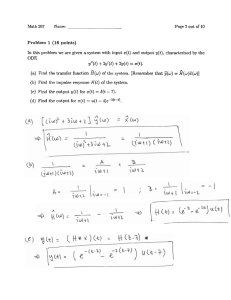
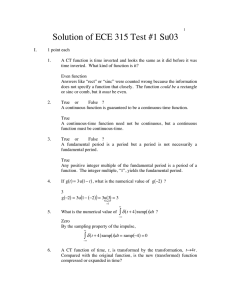
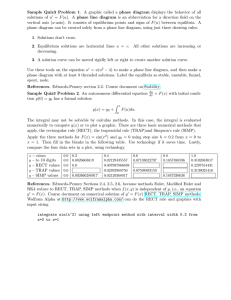
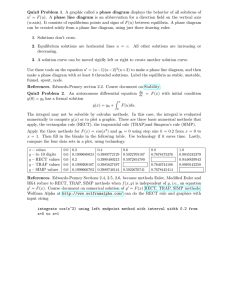
![[ ] [ ] ( )](http://s2.studylib.net/store/data/011910597_1-a3eef2b7e8a588bc8a51e394ff0b5e0e-300x300.png)
